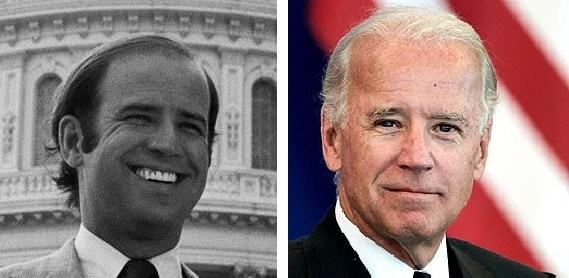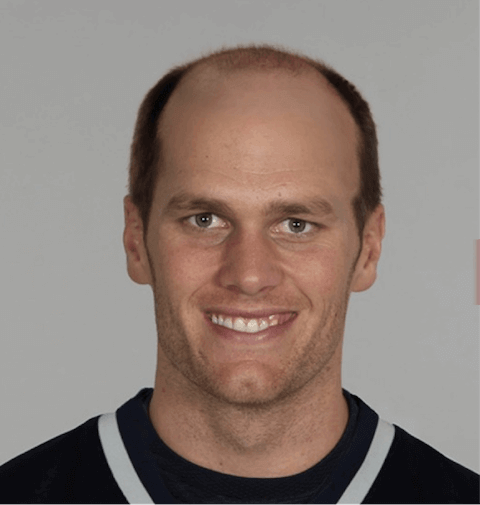What is Wrong with Joe Biden’s Hair Transplant?

Joe Biden Before And After Hair Transplant
Originally Posted November 4, Updated July 23, 2020
Joe Biden is no stranger to the public or to our blog. In November 2013, we discussed the issues with his famous “hair plugs” (see below). Now that Biden will be running against Donald Trump in the fall, his hair transplant (along with additional plastic surgery procedures) is often a topic of discussion and the subject deserves an update for fans of politics and celebrities.
Supply and Demand Mismatch of Hair
Several years ago, I had a conversation with a 31-year-old patient of mine that was insisting on having a hairline that was low and broad. During a close evaluation of his hair loss and hair transplant pattern, as well as a microscopic evaluation of his scalp, I noticed he had significant miniaturization throughout the top and crown area of his scalp. This was clearly a sign that he was heading towards Class VI or VII of hair loss which means he will eventually only have a rim of hair around the scalp.
I informed the patient that, when I design a hairline, I have to take the progress of hair loss over time into consideration. A good hairline is one that looks good now and will also continue to have a natural look when the person is in his 60s or 70s (unlike both Joe Biden and Donald Trump).
Hair Line Positioning
The hairline of Mr. Biden is an example I use when I have to plan for a higher hairline for younger adults. Many of these younger patients have hopes of achieving a lower hairline which is possible when there is no evidence of advanced hair loss.
When I see microscopic evidence of a future class of hair loss or a patient has a significant family history of high-grade baldness, I have to be more conservative in my approach in order to avoid any issues that can be seen in people with hair loss like Joe Biden.

Joe Biden Hair Transplant Problem Areas
- Poor design and poor long-term planning
- Hairline that is too low for someone with advanced hair loss
- Hairline that is too broad for this stage of hair loss
- Lack of sufficient hair to restore the crown
- Large balding area that needs more coverage
- Not enough donor grafts to cover the crown
By keeping the hairline higher as well as creating the appearance of some corner recessions, a natural look is created for the hairline. This is helpful in the long run because, even if the patient loses the crown and has no intention of restoring it, a higher hairline usually goes hand in hand with a balding crown so there is not an unnatural look to the hairline.
Do I Have to Shave My Head Before a Hair Transplant?
Q:
Hi Dr. Mohebi,
I am planning to undergo an FUE hair transplant to add greater density to my hair in the front and along the hairline. Do you always shave the patient’s hair before a hair transplant? Is there a way it can be performed with long hair?
A:
Thanks for the question.
It is usually not mandatory to shave a patient’s head before an FUE procedure. Both types of hair transplant (FUE or FUT/strip) can be performed with minimal or no shaving.
- In the strip method, shaving can be limited to the area of the strip that will be removed so the patient will have long hair on both sides of the wound so it will be covered. With the FUE method, the donor shaving can be done in layers which means the longer neighboring hair can cover easily cover the shaved area. Layer shaving in FUE transplant can only eliminate the appearance of a shaved head if you leave your hair longer on the back and sides. We recommend complete shaving whenever possible since it allows us to expand the donor area to the entire permanent zone. That increases the evenness of the hair on the donor area and avoids the minimal contrast between the extracted and neighboring areas with higher density.
Shaving the donor area in layers allows us to harvest up to 2000 grafts in one day. However, it might not be possible to harvest more than that amount. For larger sessions, we need to have access to the entire donor area so shaving in layers might not be possible.
- We offer Celebrity Hair Transplant (non-shaven FUE) so the patient doesn’t need to have any shaved areas on the donor or recipient area. This procedure is more labor intense so fewer grafts could be transplanted in each session and it is more expensive for the same reason.Celebrity Hair Transplant is popular among celebrities who do not want any evidence of a hair transplant (even in the first few days after the procedure). This hair restoration technique allows the surgical team to either excise the grafts with long hair or cut only the hair that needs to be harvested so there is no visible shaved area on the back of the head.
Do I need to shave my head for a hair transplant?
Non-Shaven FUE – FAQ With Dr. Mohebi.
Do you have a question for Dr. Mohebi? If so, Contact Us today!
Can Science Predict Male Hair Loss Patterns?
 A group of researchers at the University of Edinburgh have come to the conclusion that the genetic process of hair loss involves 287 genes. Furthermore, they also say they have come up with a formula that predicts the risk a man runs of losing his hair. Even with this formula, the team says it is still too soon to predict whether or not a blood test can show if, and when, hair loss will begin for a man.
A group of researchers at the University of Edinburgh have come to the conclusion that the genetic process of hair loss involves 287 genes. Furthermore, they also say they have come up with a formula that predicts the risk a man runs of losing his hair. Even with this formula, the team says it is still too soon to predict whether or not a blood test can show if, and when, hair loss will begin for a man.
According to an article published in the peer-reviewed open-access journal, PLOS Genetics, the results of the study might be able to help identify males at a larger risk of hair loss. If the men are able to be identified, they might also be possible “genetic targets” to help prevent any possible hair loss by intervening before it
occurs.
According to Ricardo Marioni and his University of Edinburgh research colleagues, the total of 287 genetic signals linked to the process of hair loss was determined after the researchers studied DNA from a group of more than 52,000 men who count as being middle-aged. The men took part in a large genetic experiment in Britain called BioBank.
A student involved in the project, Saskia Hagenaars, said the study was successful in identifying hundreds of new genetic signals. Hagenaars also said that many of the genetic signals involved in the process of male pattern baldness actually came from the X chromosome which is inherited from mothers.
The study group included 16,700 men with no hair loss and an additional 12,000 with a slight case of hair loss. In addition, the study included 14,000 men with moderate hair loss and 9800 study group members with severe hair loss. The research team linked the genetic pattern of each man in the study with their degree of hair loss. Men in the study group with total hair loss genes that were less than average were not likely to become bald. In this group, 14% of the men were bald and 39% of the group didn’t have any hair loss. On the other hand, 58% of the men in the top 10% of having baldness genes also showed some hair loss. According to the research group, this makes the genetic pattern of hair loss somewhat, but not completely, predictable.
The research team wrote that “male pattern baldness affects around 80 percent of men by the age of 80 years.” Having said that, they still feel that science is not close to being able to accurately predict any hair loss patterns in individual patients. According to Marioni, “these results take us one step closer. The findings pave the way for an improved understanding of the genetic causes of hair loss.”
3 Hair Restoration Techniques Showing Promise For Patients
New techniques are constantly being tested and researched to try and combat hair loss. Some might show promise and be marketed to consumers while others will never get out of the research phase. Here are some techniques currently being studied to help those who suffer from hair loss:
-
 Hair Multiplication
Hair Multiplication
A partnership between the RIKEN Research Institute of Japan as well the Japanese electronics company, Kyocera, and Organ Technologies is studying the science of hair multiplication for dealing with hair loss. The research team plans to extract the hair follicles of a patient and then multiply them through the use of cell culturing. The multiplied hair will then be transplanted back onto the areas of the scalp that are balding. The process of hair multiplication looks to solve the issue of insufficient donor hair supply on the back of the scalp. The research team is aiming for 2020 as the date for the process to be commercially available.
- Skin Perturbation
Follica is a United States company looking to combine skin perturbation (where the top layers of the scalp are peeled back) and topical compounds. The removal of the top layers of the skin prompts the skin cells that are located beneath them to change to a stem-like state. Once this happens, a topical compound is applied to the area to stimulate new hair follicle growth. This technique is designed to work on patients who have already lost their hair. Once the skin is peeled back, the cells in the area make the decision to create more skin or hair. Follica is working on trials with mice and human subjects to try and move the cells in the direction of making more hair. They hope to finish their trials sometime this year and have the technique ready for public use by 2018.
- Wnt Signal Reactivation
The biotechnology company, Samumed, released data from the second phase of their clinical trial of SMO4554 in 2016. The data showed information regarding SMO4554 which is a drug applied topically to patients with male pattern hair loss. The drug works by restarting any Wnt signaling pathways that were disrupted. These are the proteins that give instructions to a cell. The idea behind starting the signals again is that hair growth will begin again once normal cell functions have resumed. Samumed plans on starting the next phase of their clinical trials later this year which should give the public a better idea about the viability of the technique.
Weird and Wacky Historical Hair Loss Solutions
The techniques available to combat hair loss have evolved over the years to where many people take the current methods for granted. It might be hard to believe but there were ways to combat hair loss before the 20th century. Have you ever heard of any of these weird ways people attempted to combat hair loss in the past?
Ancient Egyptians used a variety of cures to help those suffering from hair loss. One of the oddest remedies was a mixture of fats that included tomcat, crocodile, hippo, snake and an ibex AKA a wild goat. Porcupine hair was also boiled and then applied to the scalp for at least four days. Egyptians who were not fans of those ideas more than likely chose the option of wearing a wig.
While Hippocrates is known as the father of Western medicine, he also suffered from male pattern baldness. What was his answer to his baldness? A topical solution made of pigeon droppings, spices, opium, beetroot and horseradish. His other cure for baldness was a little more radical as he realized that eunuchs were not lacking hair on top of their heads. There are no records of how many people choose the castration solution.
Julius Caesar might be the father of the comb over. Once he started losing his hair, he turned to growing his hair long in the back and then brushing it up and over his scalp. When this didn’t work, he turned to a remedy consisting of bear grease, mice and horse teeth. When that rather unappealing solution didn’t work, Caesar finally decided on wearing a laurel wreath on his head to cover his bald area.
The phrase “snake oil salesman” is used to describe someone who is not particularly trustworthy. The 19th century saw many salesmen pretending to be doctors while trying to sell potions and products to cure baldness. Most of these tonics were simply drinks made by the salesmen that had no medical value in treating baldness or any other ailments.
These crazy ideas to combat baldness are just a few of the methods used throughout history to battle hair loss. We’ve come a long way since the days of potions made from a combination of animals found in the great outdoors. We should all be glad that we live in a day and age where modern medicine is able to provide effective hair restoration solutions.
He Won The Super Bowl – Can He Beat Hair Loss?
Tom Brady is still living a charmed life as an NFL quarterback. He moved from the New England Patriots to the Tampa Bay Buccaneers and is in the NFL playoffs with another chance to go to the Super Bowl. After his last game, he stood on the field looking very much like a football player with an athletic build and a perfect head of hair. Tom Brady’s hair has been a subject of speculation for many years and starts with looked to be a loss in the battle against hair loss.

Tom Brady Hairline Issues
Looking at Tom Brady’s life from the outside, he seems to be living the good life:
- A successful NFL career
- Hot supermodel wife
- Adoring fans
There have been a few stumbles along the way (Deflategate and Super Bowl losses) but, in general, Tom Brady has been very blessed in his life.
One area where Tom becomes more like us mere mortals is his hairline. Maybe that should be phrased “his lack of a hairline”. There has been some speculation for many years that Tom Brady has been losing his hair and has even undergone a hair transplant. Neither Tom nor his wife have confirmed this news. However, there have been conflicting reports over the years about Tom Brady and his receding hairline.
Here are just some of the stories surrounding Tom’s head:
- The first sign that Tom was losing his hair was when he started to wear his ever present cap. Tom was seen wearing this pom pom hat on the field, in the locker room and even at press conferences. Some people might see the hat as nothing more than a fashion statement where he is supporting his team. Others view it as a sign that Brady was losing his hair and didn’t want that fact to become public knowledge.
- Back in 2010, it was also reported that Brady’s car was seen outside the office of Leonard Hair Transplant Associates in Rhode Island. There is a theory that Tom was being a good guy and was just giving a friend a lift. There is also the likely explanation that he was consulting with the staff about his own hair. Did Tom get some work done that day or was he simply discussing his hair restoration options?
- Following the 2010 “Rhode Island incident”, as well as a 2008 visit to a hair restoration clinic, Tom Brady’s hair has gone through a number of styles over the years. His hairstyle has ranged from being close cut to a head full of long locks and even a period where Tom had a shaggy style. Tom’s hair has been a changing work of art. It has been reported that Tom had thinning hair on his scalp along with a bald spot that his wife was desperate to prevent from getting out of control. It has also been speculated that his wife made Tom Brady get hair plugs to stop his hair loss.
Unfortunately, all of the above stories, sightings and gossip are pure speculation. Tom’s father was bald so many experts feel that Brady is also worried about being bald at some point in the future. Until Brady himself decides that it is time to speak publicly on the matter, the truth behind Tom Brady’s ever-changing hairline will not be known by the public. Until then, fans of Tom Brady should enjoy the current look of Brady’s hair because it could just as easily look like the picture below without the help of experienced medical experts.

What’s So Funny about Going Bald?
In an extreme case of the pot calling the kettle black, comedian Larry David has stated that professional golfer Jordan Spieth is going to be “wildly bald”. Spieth is 22 years old and has already won two major tournaments this year (the Masters and the U.S. Open). David is the co-creator of “Seinfeld” and the creator and star of “Curb Your Enthusiasm”. The two men have a few things in common.
 Spieth is a professional golfer. David is not only an avid golfer but he is also a big fan of professional golf. Spieth has a rapidly receding hairline. David has already lost a good portion of his hair.
Spieth is a professional golfer. David is not only an avid golfer but he is also a big fan of professional golf. Spieth has a rapidly receding hairline. David has already lost a good portion of his hair.
While David is a big fan of Spieth’s ability to handle himself on the golf course, he can’t wait to see how the young golf pro handles a different kind of pressure. In the latest issue of Golf Digest, David says he is very interested in seeing how Spieth handles seeing all of his hair in the bathtub. David then makes a prediction that Jordan Spieth has only three or four years left before he is “wildly bald”. How he reacts to the pressure of going bald is of great interest to Larry David. In fact, it sounds like Larry David can’t wait for the day Jordan Spieth loses all of his hair.
How did Spieth react to the comments of Larry David? The young golfer seems to have a good attitude and took it all in stride. In fact, he remarked that David’s comments were funny and there is nothing he can do about his impending hair loss.
We’d like to point out to Jordan Spieth that there is plenty he can do about his hair loss. He made $1.8 million dollars for winning the Masters and the same amount for winning the U.S. Open. With that amount of money, Spieth can afford any hair transplant procedure he wants in the future.
Just remember Jordan…Your friends at Parsa Mohebi Hair Restoration are here for you. Give us a call to set up your consultation appointment!
Do the Effects of Propecia Level Off After Three Years?
Q:
Good day Dr. Mohebi,
I hope everything is fine with you. I have a question about Propecia. I have been taking it for few years now. I remember you mentioning in the past that Propecia effects level off after 3 years.
If this is the case, should I continue taking it ?
I look forward to your answer.
A:
It is good to hear from you.
The effects don’t level off but, it’s important to note, you won’t continue seeing the initial effects that had been noticeable due to the initial enlargement of some of the miniaturized hairs. You have been making DHT all along but at a lower level as time passes.
At this point, it is still slowing down your hair loss. If you stop taking it, you will see a more aggressive loss of your native hair that is prone to balding.


